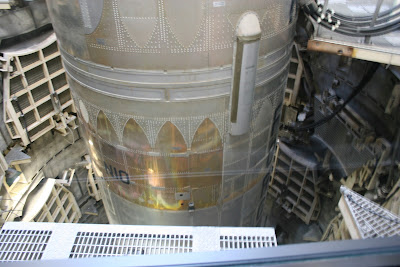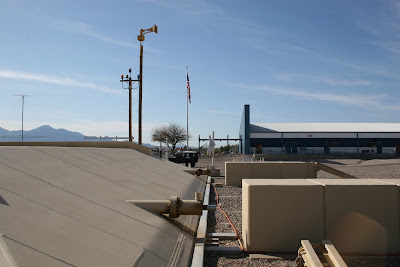Of the 54 Titan missile silos throughout the US, 18 were in the Tucson area. This is the last one still maintained as though the cold war was still on. The site is still owned by the Air Force but is maintained by a non profit preservation organization.
Inside the entrance are a few museum displays documenting the construction of the silo and a few uniforms that would have been worn by the 4 soldiers who would operate the entire silo on 24 hour shifts.
The 4 man teams would be made up of 2 enlisted and 2 officers. Much of the interior of the silo was accessible by only two man teams. This policy was for safety and security. There were a number of ways to get hurt in the silo and without having a teammate nearby you could be in a lot of trouble very quickly. The security aspect is obvious enough, after all there was one of the largest hydrogen bombs in the US arsenal sitting atop a 100 foot tall rocket in the next room.
 |
| View of the top of the missile from the partially open silo door. |
Titan missiles were not only used to deliver the threat of Mutually Assured Destruction. These very powerful and capable missiles were used to deliver many much less destructive payloads into outer space. Their engines were a marvel of power and simplicity (if not fuel economy). The first stage of the Titan engine provided some 548,000 pounds of thrust. Between the first and second stages the Titan missile was capable of accelerating to 15,000 mph and a apogee of 800 miles.
One would think that security at a nuclear missile silo would have been massive, in fact it was not at all. The site was generally manned only by the 4 person crew on duty and this particular site is within a Randy Johnson stones throw of the highway. The security was mostly provided by the shear impenetrability of the silo itself. Above ground you had fences with razor wire and within those fences was land based radar that would detect any movement.
 |
| Two of the radar detection devices. |
If movement was detected above the silo an enunciator within the control room would alert the on duty officers. Security would then be called, none of the on duty staff would leave the silo to investigate. The staff would rely on the steel reinforced 8 foot thick walls and the 3 ton blast doors to prevent the intruder from entering until help arrived.
After a brief movie and a tour of the grounds above the silo (including the rocket engines) you begin your decent to the control room.
 |
| 1960'2 era closed circuit TV |
 |
| One of the 2 massive 3 ton blast doors you must pass through to get to the inner silo. |
 |
| The control room. This room is part of a separate 3 story underground building attached to the silo via a corridor. |
 |
| The entire three story underground crew area is suspended on massive springs as part of the facilities ability to absorb a nuclear blast above ground. |
Most folks who have ever watched any WWIII or atomic doomsday movie know that the launch of a nuclear missile requires the turning of two keys and the entry of a code. This particular silo had a code with 16,777,777 possible combinations as well as the keys set about 10 feet apart so that they had to be operated by at least two people. During the tour you will simulate a launch as the docent and a volunteer turn the two keys. During our tour, the system malfunctioned! Even though I knew the entire facility had been deactivated, the fact that the system that prevented the entire world from being destroyed in nuclear hellfire malfunctioned was ominous to say the least! I could actually feel a lump in the pit of my gut. The docent went on with the show resetting different alarms as they went off. He made a few quick jokes about somebody owing them 2.2 million dollars if the missile did launch, then took us down the hall to the silo.
 |
| Hi fidelity! |
 |
| The Titan still at home in it's silo. |
 |
| The brownish looking cone on the side of the rocket is a retro rocket used to steer the missile toward the pre-programmed "Target number 2" still classified to this day. |
 |
| The skin of the Titan is made of aluminium and is roughly the thickness of a dime. |
 |
| Two maintenance suits hanging near the silo. |
I plan to come back at some point and take one of the "top to bottom" tours that take 4-5 hours.
Overall I thought it was a great tour. Jerry, our docent, worked at the facility when it was active and was a fountain of knowledge.
Anyone interested can find more information at Titan Missile Museum.
Be Good!
Have a Great Day!
Noah








Have you guys been to the Atomic Testing Museum in Las Vegas? If not, you need to put that on your to do list.
ReplyDeleteWe haven't - but now we plan on going there. Thanks for the suggestion!
ReplyDelete